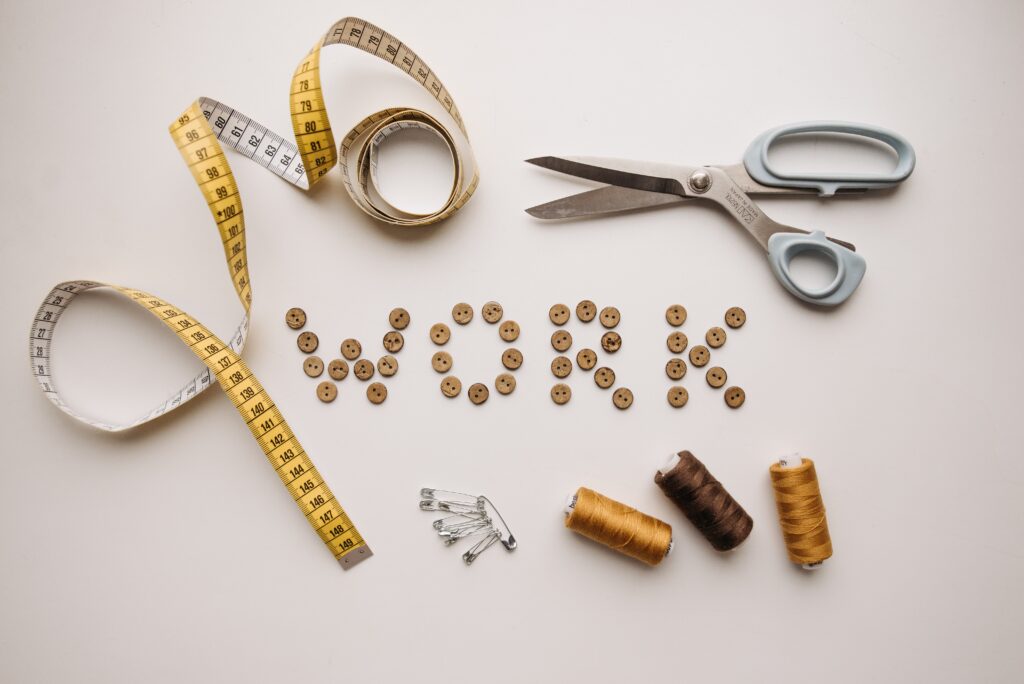Table of Contents
Introduction
In the world of do-it-yourself (DIY) emergency repairs, one humble tool stands out as an unsung hero: the safety pin. Often relegated to the realm of sewing kits and accessories, these small pins are, in fact, versatile problem-solvers who can come to your rescue in a wide range of emergencies. This comprehensive guide will walk you through various ingenious and practical ways to use these pins, transforming them from simple sewing tools into indispensable assets in your everyday life. Whether it’s a wardrobe malfunction, a household crisis, or an outdoor adventure, pins can be your trusty companions, ready to save the day. So, let’s dive into the world of emergency repairs with safety pins.

Emergency Wardrobe Malfunctions
1. Fixing a Broken Zipper
Safety Pin Magic: We’ve all been there – a zipper that refuses to cooperate when you need it the most. This simple pin hack can save the day. Here’s how to do it:
- Trow a safety pin through the hole in the zipper pull.
- Fasten the pin to the fabric, ensuring the pull replaces the missing zipper head.
- You can now zip up your garment as if nothing happened.
This quick fix will keep your clothing functional until you can arrange a professional repair or replacement.
2. Securing a Falling Hem
Quick Fix: There’s nothing more embarrassing than a hem that suddenly comes undone while you’re out and about. A safety pin can come to the rescue in these situations:
- Fold the fabric back to its original position.
- Use a pin to secure the folded fabric discreetly.
- Ensure the pin is fastened securely but not too tight to avoid damaging the garment.
This ingenious solution will keep your clothing in place until you have the time to sew the hem properly.
3. Rescuing a Lost Button
Button Savior: Losing a button from your shirt or coat can be a real nuisance, but a safety pin can offer a temporary solution:
- Thread the safety pin through the buttonhole where the missing button used to be.
- Attach the pin to your garment, ensuring it’s securely fastened.
This quick fix will hold your clothing together until you can sew the button back on securely.
Household Emergencies Fixed with Safety Pin
4. Emergency Lock Replacement
Lock Troubles: Discovering that your door lock is jammed or broken can be distressing. In such an emergency, a safety pin can serve as a makeshift key:
- Bend the pin to create a hook at one end.
- Insert it into the lock’s keyhole.
- Carefully maneuver the pin to imitate the function of a key.
- Gently turn the pin to unlock the door just as you would with a key.
This ingenious emergency solution can help you gain access to your space until a professional locksmith arrives.
5. A Quick Hose Repair
Leaky Hose Fix: When your garden hose springs a leak, you can temporarily repair it using a pin:
- Locate the area of the leak.
- Thread a pin through the hose wall, covering the hole.
- Wrap waterproof tape around the pin and the hose to create a secure and watertight seal.
This temporary fix will prevent further water loss and buy you time until you can perform a more permanent repair or replace the hose.
6. Broken Glasses Frame
Temporary Glasses Fix: If your eyeglasses frame breaks, you can use a pin to hold it together temporarily:
- Thread the safety pin through the hinge that connects the broken pieces.
- Ensure that the pin is securely fastened.
- Be cautious while wearing the repaired glasses and seek professional repair or replacement as soon as possible.
This is a temporary solution to help you see clearly until you can get your glasses fixed professionally.
Camping and Outdoor Solutions
7. Tent Repairs
Tent Troubles: Finding a tear in your tent fabric while camping can be a camping enthusiast’s nightmare. Safety pins can be your saviors in this situation:
- Locate the tear in the tent fabric.
- Use safety pins to secure the edges of the tear, preventing it from expanding and keeping you dry and sheltered.
This temporary fix will keep you comfortable on your camping trip until you can arrange for proper tent repairs.
8. DIY Fish Hook using a Safety Pin.
Fishing Aid: Imagine you’re out fishing and realize that you’ve forgotten your hook at home. With a safety pin and a little creativity, you can craft a makeshift hook:
- Bend the pin to create a hook shape.
- Attach your fishing line to the closed end of the pin.
- You now have a functional makeshift hook to continue your fishing adventure.
This clever trick can save the day and turn a potential disappointment into a successful catch.
First Aid and Health
9. Splinter Removal
Safety Pin Precision: Dealing with splinters can be painful and challenging. A sterilized pin can be an invaluable tool for splinter removal:
- Sterilize the safety pin by cleaning it with alcohol or boiling it.
- Gently pierce the skin at the point of entry of the splinter.
- Carefully maneuver the pin to dislodge the splinter.
- Once the splinter is exposed, use the pin to extract it from the skin.
This precise and sterile method can effectively remove splinters and alleviate discomfort.
10. Blister Draining
Blister Relief: Blisters can be painful, and draining them can provide relief. Here’s how to do it:
- Sterilize a safety pin, as mentioned above.
- Gently pierce the blister, creating a small hole to allow fluid to escape.
- After draining, apply an antiseptic and cover the blister with a bandage to prevent infection.
This method can relieve the pressure and help heal blisters, making your discomfort more bearable.
Safety Precautions While Using a Safety Pin
Using safety pins at home, whether for mending clothes or addressing various emergencies, is a common practice. However, it’s crucial to exercise caution and care to ensure that these small but versatile tools do not inadvertently cause harm or accidents. Here, we’ll explore the essential precautions and best practices to keep in mind when using safety pins in a household setting.
- Proper Handling: First and foremost, handling safety pins with care is crucial. Their sharp ends can easily puncture the skin, leading to injury or infection. When picking up a safety pin, do so gently and avoid sudden movements that might cause it to slip or poke you.
- Sterilization: Before using safety pins for medical or first aid purposes, sterilize them. This can be done by wiping the pin with alcohol or boiling it in water. Sterilization reduces the risk of infection when you use a safety pin to address a wound, splinter, or blister.
- Splinter and Blister Care: Take your time and exercise precision when using safety pins to remove splinters or drain blisters. Avoid excessive force or trying to rush through the process. Gently insert the pin at the point of entry of the splinter or create a small hole for blister drainage. Afterward, clean the area, apply an antiseptic, and cover it with a bandage to prevent infection. It’s also advisable to wash your hands before and after these procedures to maintain cleanliness.
- Safe Storage: Ensure that safety pins are stored safely, away from the reach of children or pets. These small objects can easily be swallowed, leading to choking hazards or other health issues. It’s best to store them in a container or a secure sewing kit to prevent accidents.
- Wardrobe Maintenance: When using safety pins for quick wardrobe fixes, ensure they are fastened securely but not too tight. Too tight pins can damage the fabric and worsen the situation. Use safety pins as a temporary solution until you can perform a more permanent repair.
- Emergency Lock Replacement: Be patient and gentle when using a safety pin as a makeshift key for a jammed or broken lock. Avoid using excessive force, as this could damage the lock further. If you are unsure about this method, contacting a professional locksmith is always best to avoid mishaps.
- DIY Fishing Hook: When crafting a makeshift hook from a safety pin, securely fasten it to your fishing line. Test it carefully to ensure it can withstand the weight of the fish you’re trying to catch. Consider other alternatives to avoid losing your catch if it appears flimsy or unstable.
- Hose Repair: When fixing a leaky garden hose with a safety pin, ensure the pin is placed securely through the hose wall and that waterproof tape is used to create a tight seal. This is a temporary fix; for a permanent solution, consider replacing the hose.
- Proper Disposal: When safety pins become damaged or unusable, dispose of them responsibly. Sharp objects like these should be placed in a puncture-resistant container, such as a thick plastic bottle, to avoid injuries during disposal.
- Caution in Multi-Person Households: In households with multiple family members or roommates, be sure to communicate the presence and use of safety pins. Awareness of where they are kept and how they are used can help prevent accidents and mishandling.
- Regular Inspection: Inspect safety pins for signs of damage, rust, or dullness. Damaged pins may not work effectively and could pose safety risks. Replace any pins that are in poor condition.
- Adult Supervision: If children or teenagers need to use safety pins for a school project or other tasks, it’s advisable to have adult supervision to ensure they are used safely and responsibly.
In summary, while safety pins are incredibly useful tools for various tasks, they should be used with care and respect for their potential risks. Proper handling, sterilization when necessary, and safe storage are essential practices. When using safety pins for medical purposes, splinter removal, blister drainage, or any situation where they may come into contact with the skin, follow recommended hygiene practices to prevent infection. By adhering to these precautions and best practices, you can enjoy the versatility of safety pins while minimizing the potential for accidents and injuries in a household setting.

Conclusion
Safety pins are not merely sewing tools but versatile, indispensable assets in emergencies. From fashion mishaps to household repairs camping adventures to first aid, safety pins have proven to be invaluable time and again. Keep a few pins in your emergency kit or sewing box, and you’ll always be well-prepared for unexpected situations. Remember the simple yet invaluable safety pin the next time you face a crisis.
Incorporating safety pins into your emergency repair toolkit can make a significant difference when you’re in a bind. These ingenious hacks demonstrate that these pins are not just for mending clothes; they are multifunctional tools that can help you navigate a variety of unexpected situations. By following these detailed instructions, you’ll be well-prepared to tackle emergencies with ease, whether they involve your wardrobe, household, outdoor adventures, or personal health. Safety pins are small, unassuming, and affordable, but they can truly save the day when you need them the most.
Photo by Nidheesh K, Pavel Danilyuk
1 thought on “Safety Pin – The Ultimate Powerful Tool for Emergency Repairs”